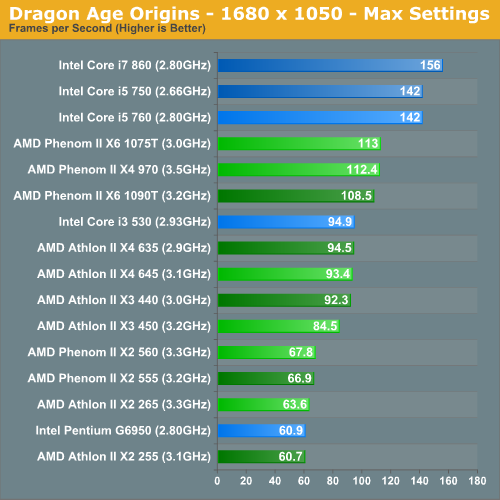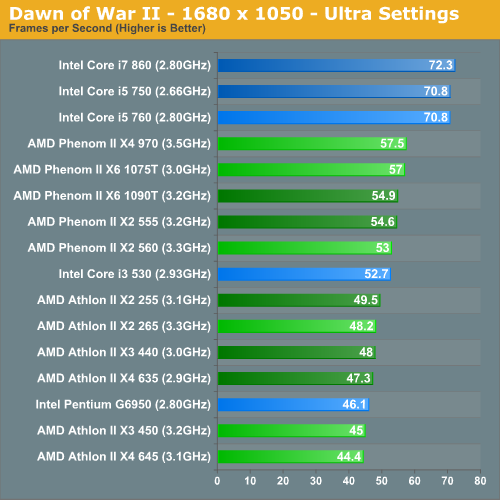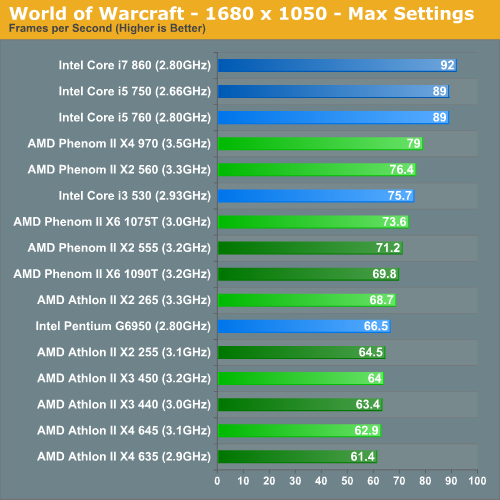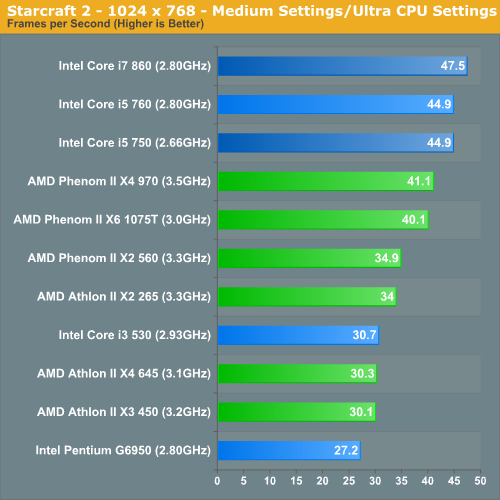AMD's Fall Refresh: New Phenom II and Athlon II CPUs Balance Price and Performance
by Anand Lal Shimpi on September 21, 2010 2:52 AM EST- Posted in
- CPUs
- AMD
- Phenom II X6
- Athlon II
Sonar 8 Audio Mixing Performance
In our only digital audio production test we take a multi-track recording and export it to a WAV file using Sonar 8. The benchmark isn't very well threaded and prefers two very fast cores to several slower ones:

As I mentioned before, this is the biggest issue with AMD's lineup. If you're running applications that can't use the extra cores, AMD's advantage typically disappears.
Gaming Performance

At the high end, AMD's Phenom II X6 and X4 lose to the similarly priced Lynnfields. In the middle the Athlon II X4 645 and Athlon II X3 450 do very well.

With the exception of the Phenom II X6 and X4 processors, AMD is generally competitive here. Intel maintains the performance advantage above $200. There's an unusual amount of variance in our tests here (particularly old vs. new AMD results). The variance appears to be caused by the platform shift as we moved all of our AMD testing to the same 890GX motherboard. The change in performance under Dawn of War II however doesn't really change the standings.

WoW performance is governed by two threads thus negating any core count advantage. AMD loses at the high end but is competitive around the $100 mark.

Starcraft 2 performance is something we're beginning to look at. Again we have a situation where a game doesn't use more than two cores. The Phenom IIs are slower than Lynnfield, while the multi-core Athlon IIs do well against their competitors. If you're building a fast Starcraft 2 box that doesn't have to do anything else, the dual-core CPUs do better here.










98 Comments
View All Comments
Brucmack - Thursday, September 23, 2010 - link
I'm sure it's fairly easy to come up with a couple of realistic scenarios to use. There are only really three variables - # of hours idle over lifetime, # of hours load over lifetime, and average cost of power over lifetime - where it should be fairly easy to come up with some numbers to give a good idea. A useful metric might be to say "given a cost of electricty of X, the breakeven point between processors A and B is after Y hours of use".The whole point of benchmarks isn't to say "here's how it will perform for everyone!", but to give readers an idea of how the product performs in some specific (and hopefully realistic) situations, thereby allowing them to make informed decisions based on their own needs.
AtaStrumf - Wednesday, September 22, 2010 - link
I ditto that! Price is such an important factor it should be part of the graphs or do up a separate set of graphs with performance per $ per application, that'd be awesome. I know that ill be quickly outdated but just put date next to the graph and that'll make it very obvious to take that into consideration when looking at the graph.BernardP - Tuesday, September 21, 2010 - link
The sweet spot is the AMD lineup seems to be the Phenom II X4 955BE. For $ 145, you get a fully enabled 3.2 GHz quad-core with L3 cache, that you can easily set yourself @ 3.6 GHz with little or no voltage increase.Dark_Archonis - Tuesday, September 21, 2010 - link
Yet it will still lose to the i5 750 in virtually every benchmark. The real "sweet" spot is being able to get an i5 750 for a good price. I've seen them on sale at some places for as low as $170-175. At that price you'd be crazy to choose a Phenom II X4 955BE over it.LordanSS - Tuesday, September 21, 2010 - link
Depends if all you have to do is just replace whatever processor you have in your socket, atm.In AMD's case, you can just swap out the processor on most AM2+ motherboards and it'll just work. On Intel's case, chances are you'll have to get a new motherboard (and quite possibly RAM, if your system is old enough).
Been thinking of getting one of those 955BEs for myself. Not much of an upgrade to my main machine that's running a 940BE, but then I can pass on my older processor to my second box which is running an X2-6000 of ancient times.
Lolimaster - Tuesday, September 21, 2010 - link
Why an obsolete CPU when for the price of an i5 quad you get a 1055T wich a better chip overall with a lot of future proof.Besides 1055T, X4 955 is only one option below it's price (then the value segment with AII X4/X3).
Dark_Archonis - Wednesday, September 22, 2010 - link
Future-proof? You DO know that Bulldozer won't work in current AMD motherboards, right? What would you be upgrading to exactly from a 1055T? A Llano?Madmanden - Wednesday, September 22, 2010 - link
Perhaps he meant 6 cores vs. 4 cores, so more future proof in regards to newer, more threaded software and games.KaarlisK - Tuesday, September 21, 2010 - link
Just look at the power consumption (even idle) of the newer chips compared to the older ones.Or maybe it's just binning.
quiksilvr - Tuesday, September 21, 2010 - link
That's the big selling point for me. I'm willing to spend an extra $50 to save even 10 watts because over the life of the computer I will get that money back in electricity savings, maybe even more so.